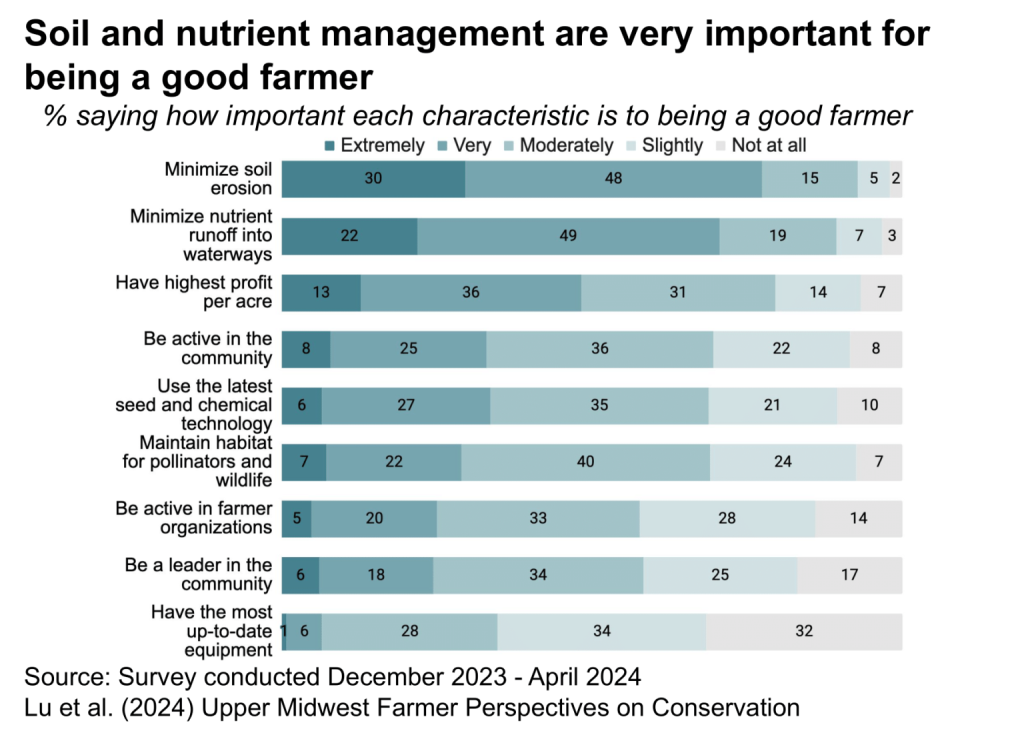

Helping growers in the Upper Mississippi River Basin provide not just food and fuel, but also clean water, wildlife habitat, and other natural benefits requires understanding farmers — how they think, what motivates them, and what might get in their way.
FEWscapes researchers recently surveyed farmers in eight Midwest states about their conservation views and practices. Their goal was to inform policies that encourage farm practices like cover crops, no-till, and pollinator or prairie plants. The survey results suggest that farmers in the Midwest are likely to react positively to policies that advance conservation goals — as long as those policies also take farm profitability seriously.
The survey asked farmers to rate how important a variety of characteristics and actions are for being a “good farmer,” a concept that taps into a body of social science research on how farmers think about their work and themselves.
The top two results were “minimize soil erosion” and “minimize nutrient runoff,” with 78% and 71% of respondents, respectively, rating them as extremely or very important.
“Land is very important for farmers, and they indeed highly value soil and water conservation,” said lead survey researcher Yu Lu, a PhD candidate in Human Dimensions of Ecosystems Management at the University of Wisconsin-Madison. Lu is advised by FEWscapes researcher and study co-author Dr. Adena Rissman.

Productivists and Conservationists
Research on the “good farmer” concept has revealed several recurring patterns in farmer identity.
For instance, “productivist” farmers tend to view their goal as maximizing yields and profits and using the most-up-date equipment. “Conservationist” farmers might use many of the same practices as productivists, but they tend to focus more than their counterparts on priorities like soil health or the long-term value of their land.
In the FEWscapes survey, how farmers responded to the “good farmer” question signaled their farmer identity archetype. Those that prioritized minimizing soil erosion, nutrient runoff, and maintaining habitat for pollinators and wildlife are more likely to be conservationists. Those that chose having the highest profit, using the latest technologies, and having the most up-to-date equipment are more likely productivists. Responses about being active in community and farmer organizations are meant to represent “civic-minded” farmers, a third identity archetype.
Past research has also shown that farmer identities are significant predictors of support for conservation-oriented policy proposals and use of specific farm practices. Conservationist farmers are more likely to plant trees or prairie on their farms, for instance, than farmers with a stronger productivist identity.
“Farmers’ identity is very important when they make decisions about land practices,” Lu said.
Conservation on Midwestern farms
The FEWscapes survey also highlighted this link between identity and management. According to the survey, respondents use conservation practices widely. A majority implement conservation tillage and nutrient management plans on most or all of their land. Other conservation tools were somewhat less common: 44% of farmers used no-till planting on most of their land, 21% used cover crops, and 14% used buffer strips.
In follow-up interviews, Lu asked farmers what their most important production goals were. Many framed their responses in conservationist terms, telling her that “when they give the land to the next generation, they want the land quality — soil and water quality — to be better than when they got the land from their parents,” she said.
Importantly, farmer identities are not “all or nothing” — rather, farmers often balance a variety of values when making decisions.
In a separate survey question about farmers’ top concerns, 78% said they were “extremely” or “very” concerned about farm profitability.
And on the “good farmer” question, 49% of responding farmers rated “have the highest profit per acre” similarly important to the top-scoring conservation goals. This result implies that productivist values are also widespread.
Taken together, the survey results suggest that for Midwestern farmers – and the professionals and policymakers looking to support them – profitability and conservation need not be contradictory goals.
Read the full survey brief by Lu, Rissman, Lillian Herling, Maddie Olson, and Eliza Eyman.
Header photo: Cover crops line both sides of a stream in a Washington County, Iowa, farm field. By Lynn Betts, NRCS/Soil and Water Conservation Society.